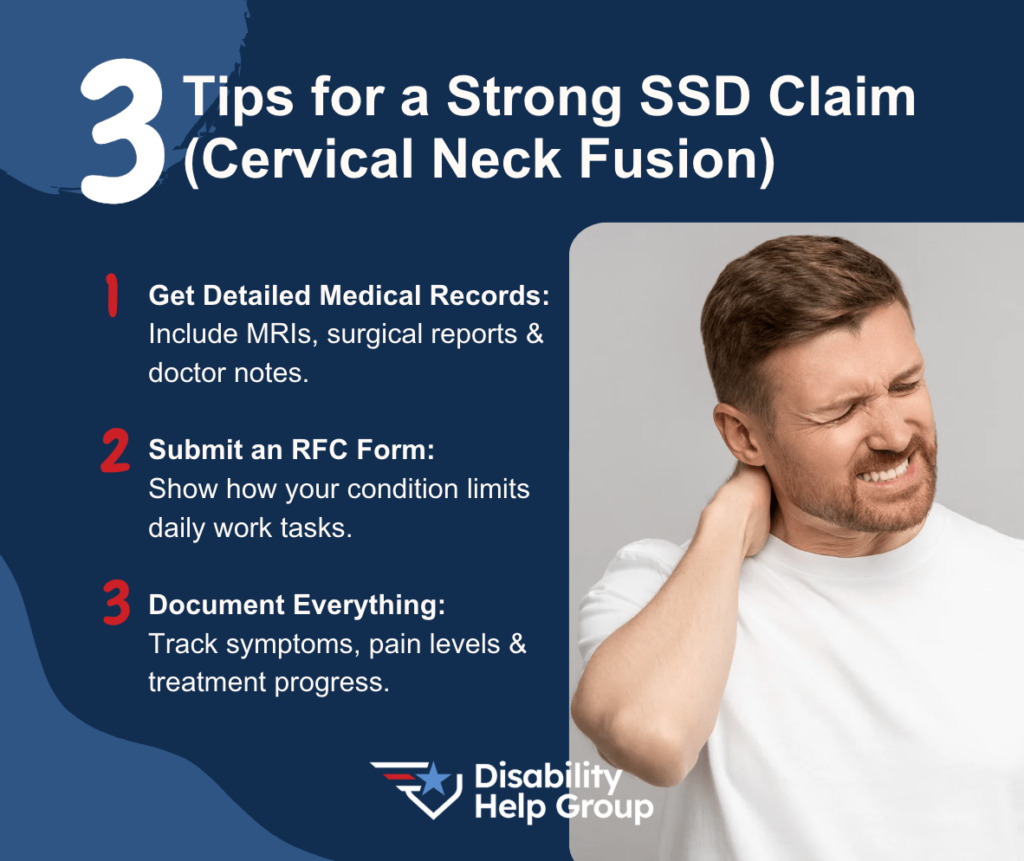Cervical Neck Fusion and Social Security Disability
Cervical Neck Fusion and Social Security Disability. You may qualify for Social Security disability benefits if you’ve had a cervical neck fusion. However, you must show that you still can’t work. Many different problems can cause neck pain and other symptoms. Typically, degenerative disc disease, whiplash, herniated discs, and arthritis can cause ongoing symptoms. Neck impairments can cause many different symptoms.
These symptoms may include:
- Pain
- Limited movement of the neck or shoulders
- Headaches
- Shooting pain down the back or arms
- Numbness and/or tingling
Getting Disability For Cervical Neck Fusion
You may qualify for Social Security disability benefits for your cervical neck fusion or impairments. However, you must show that your symptoms are severe. They must cause problems doing normal activities. Additionally, they must keep you from working for at least 12 months.
Social Security provides a listing of impairments, known as the “Blue Book.” The Blue Book provides specific conditions that you must meet to qualify for disability benefits. Social Security doesn’t have a specific listing for a cervical neck fusion. However, they do provide a listing for spinal disorders under 1.04.
Disorders Of The Spine
To meet Social Security’s listing for your neck problems, you must show that the nerve root or spinal cord has been affected.
Additionally, you must show:
- Evidence of nerve root compression, limited movement of your spine, and muscle weakness with loss of feeling or reflexes, or
- Spinal arachnoiditis is a painful disorder caused by inflammation that causes you to have to change positions every two hours

Getting Disability If You Don’t Meet The Listing
Many people will not meet the listing for their cervical neck impairments. Fortunately, you can still get disability benefits. Specifically, you need to show that your neck problems limit your functioning and prevent you from working. Social Security assesses your residual functional capacity (RFC.)
Particularly, Social Security considers:
- How long you can sit, stand, or walk at one time or in an 8-hour workday
- How much weight you can lift or carry
- Using your arms and hands for activities such as reaching, pushing, pulling, gripping, or grasping objects
- If pain, fatigue, other symptoms, or side effects from medications cause limitations with concentration, persistence, or pace
Cervical Neck Fusion And Social Security Disability
Here’s an example of cervical neck fusion and SSD:
Anne injured her neck in a car accident. She required a cervical spinal fusion surgery. Despite surgery, she continued to have severe pain and difficulty moving her neck. She also still had problems using her hands due to numbness and tingling. Social Security determined that she could not lift or carry more than ten pounds but could sit for six hours. Additionally, Social Security found that she had serious problems using her hands throughout the day. Therefore, she was unable to do even simple seated jobs. As a result, Anne was approved for disability benefits.
Social Security Grid Rules
Social Security uses a chart called the Medical-Vocational Guidelines to evaluate your disability claim. These guidelines are known as the “grid rules”. The grid rules make it easier for older people to win their case. Social Security understands that it may be harder for older people to do new or different work. They will look at the grid rules if your impairments do not meet the conditions under the Social Security medical listings.
Cervical Neck Fusion And The Grid Rules
Here is an example of the grid rules for Cervical Neck Fusion:
Brad, a 57-year-old man previously worked as a janitor. He filed for disability because he developed degenerative disc disease in his neck. He had cervical spine surgery. Unfortunately, he continued to have pain in his neck. His doctor told him he couldn’t lift more than 10 pounds. Social Security found he couldn’t perform the duties required to be a janitor. Under the grid rules, Social Security approved Brad’s claim.
What Medical Evidence Is Needed For Cervical Neck Fusion And Neck Impairments?
You must provide medical evidence to document any problems related to your neck problems. Generally, medical evidence includes your doctor’s treatment notes, test results, and imaging. Most importantly, you should have MRI evidence of your cervical spine.
Also, your doctor should document:
- Any pain with movement of your bones or joints
- Problems moving your neck
- Problems using your hands
- Difficulty traveling to places without assistance
- Difficulty performing activities of daily living such as shopping, cooking, cleaning, using public transportation, bathing, or getting dressed
What Are RFC Forms?
An RFC form can clearly explain how your conditions impact your functioning. Having your doctor complete an RFC form can be very helpful. After all, they should know more about your health than anyone else. An RFC form should be very detailed. It should indicate all your medical symptoms and conditions. It should also include all of your treatment and any side effects from medications. An experienced disability advocate can provide these forms to you.
Disability Help Group Can Help You
Make sure you start your claim the right way and apply for all the benefits you deserve. If you have already applied for SSI or SSDI, call immediately to make sure your case is still pending and was filed correctly. You may be entitled to significant compensation. Contact us now for a free consultation.
Related Articles
- Is Osteoporosis a Disability?
- What is the Difference Between SSI and SSDI?
- I Just Received a Function Report Questionnaire from Social Security. What Should I Do?
- Why Your SSD Claim Might Be Denied?
- What is the SSDI Payment Schedule?
- How can I Check on My Disability Claim?
- Why Should I Hire a Disability Lawyer?
- What are the Over 50 Grid Rules?
- VA Benefits Appeal
- VA Disability Remand
- What are Social Security Disability Interview Questions?







